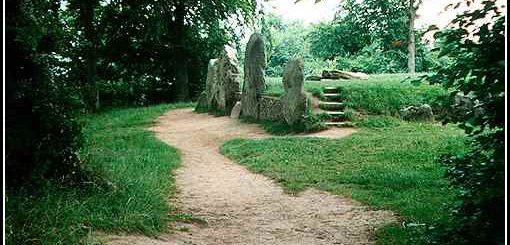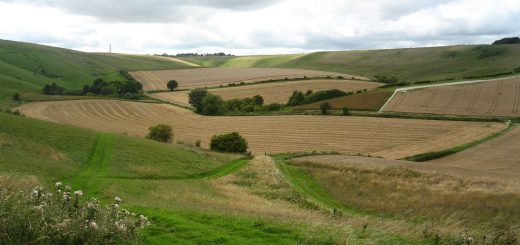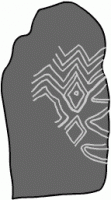Machrie Moor Stone Circles
The Isle of Arran, off the West Coast of Scotland, has many stone circles and standing stones dating from the Neolithic period and the early Bronze Age. The finest collection of circles can be found on Machrie Moor, on the West of the island. The whole moorland is littered with the remains of early man, from hut circles to chambered cairns and solitary standing stones. The focus of the site is upon six stone circles of varying structure, concentrated in a small area of the moorland.
 The most distinguishable of the circles consists of three upright red sandstone pillars, the tallest of which is just over 18 feet high. Many of the other stones within the circle have fallen and two of the granite boulders within the circle have been carved into millstones still in situ. The other tall pillar closer to the abandoned farmstead, looks like a solitary standing stone but is part of a larger circle, the stones of which have been removed or lie buried. The second most interesting circle is a double ring of squat granite boulders called Fingal’s Cauldron Seat. The outer circle is egg shaped but the inner ring of eight stones forms an almost perfect circle. When this circle was excavated a ruined cist was found but it did not contain any traces of burial.
The most distinguishable of the circles consists of three upright red sandstone pillars, the tallest of which is just over 18 feet high. Many of the other stones within the circle have fallen and two of the granite boulders within the circle have been carved into millstones still in situ. The other tall pillar closer to the abandoned farmstead, looks like a solitary standing stone but is part of a larger circle, the stones of which have been removed or lie buried. The second most interesting circle is a double ring of squat granite boulders called Fingal’s Cauldron Seat. The outer circle is egg shaped but the inner ring of eight stones forms an almost perfect circle. When this circle was excavated a ruined cist was found but it did not contain any traces of burial.
History
Although the stone circles date from around 1800 to 1600 BC during the Bronze Age period, there is plenty of evidence to suggest much earlier use of the site during the Neolithic period. At this time several timber circles were erected on the moor in the general area where some of the stone circles now lie.
The main circle consisted of about fifty tall posts with an inner ring of taller posts in a horseshoe formation. The wood circle was in use for many hundreds of years, during which time other timber circles were also created. After a long period of activity the site seems to have fallen out of favour, as the archaeology suggests a return to agricultural usage. The focus returned in about 1800BC when the construction of the stone circles was commenced.
 The main population at the time lived in small round huts, the remains of which are to be found to the West of the stone circles. It is likely that the circles were the focus of ritual activity, perhaps only accessible to a selected priesthood of the population but nobody really knows for sure.
The main population at the time lived in small round huts, the remains of which are to be found to the West of the stone circles. It is likely that the circles were the focus of ritual activity, perhaps only accessible to a selected priesthood of the population but nobody really knows for sure.
It is not clear when the site finally lost its ritual function, but it may have been a change in the climate that forced settlers to move elsewhere. The blanket peat bogs that now cover the moor developed after the circles had been completed and were the result of this shift in climate.
Folklore and Ancient Astronomy
It is quite common in folklore to find that ancient circles of stone have become associated with legendary figures and giants. These legendary figures were often used to explain the origin of the stones. At Machrie the double circle, Suide Choir Fhionn or Fingal’s Cauldron Seat, is named after the legendary warrior and giant Fingal, who is most likely derived from the Irish Warrior God Finn MacCumhail.
 According to the tradition, Fingal used the stone with the hole in it in the outer circle to tether his dog Bran, while he ate a meal within the inner ring. Fingal and his dog Bran are attached to a number of other Scottish sites. The double circle is the only that is associated with folklore, and some people have suggested that it served as the focus of the site.
According to the tradition, Fingal used the stone with the hole in it in the outer circle to tether his dog Bran, while he ate a meal within the inner ring. Fingal and his dog Bran are attached to a number of other Scottish sites. The double circle is the only that is associated with folklore, and some people have suggested that it served as the focus of the site.
As with many stone circles they may have served some form of astronomical function, related to the major festivals in the ancient calendar. John Barnatt who surveyed the area in 1978, suggested that the stone circles were in general alignment with a notch on the skyline were Machrie Glen divides into two. This notch is intersected by the sun on Midsummer’s morning. Many stone circles are aligned in this way, and the changing seasons would have been much more important to ancient man, Midsummer being the longest day of the year and the beginning of the slow march to Winter.
Directions: South of the A4 on a dirt track-way it is visible from the road.




Recent Comments